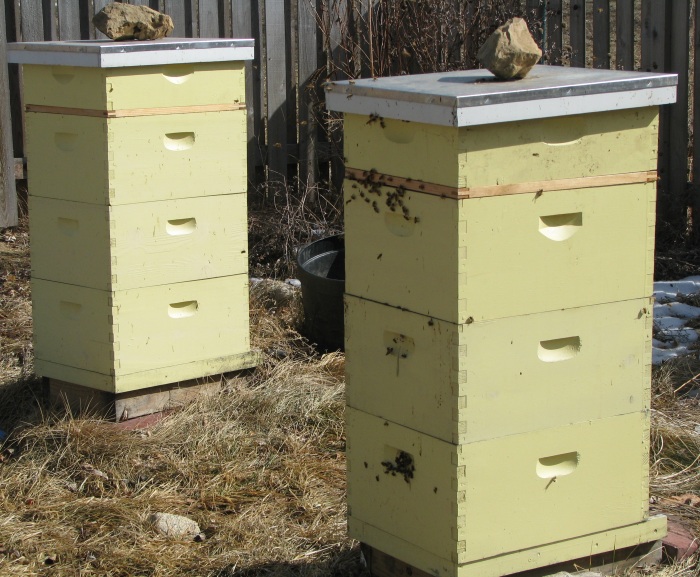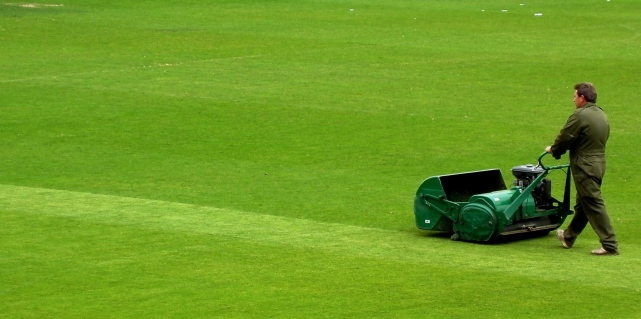Archive for the ‘Pollen and nectar’ Category
It’s a new year for the Four Horsemen Apiary!
The Great Frozen North has not been so great or so frozen this years as it was in past years; it was a very mild winter. We’re barely into March and we’re already in the 50s and 60s regularly…
…and with that comes the new year for our bees.
Jim Kloeck over at Nature’s Nectar was getting the word out that an early spring is going to mean hungry bees. We’re not going to see any blooming nectar or pollen sources for awhile, so we’ll have to tide everyone over with early rations. Ours have been doing their early cleansing flights, so it’s also time to get the hives in order for the season.
I picked up some pollen patties and a new feed bucket (we lost one last year). Gathering up my hive supplies, I trudged up the hill to get everyone squared away.
The hives in Minnesota have to be wintered with a black, waxed cardboard sheave to keep the wind and wet out. There is a bottom winterproofing board covering the mesh bottom board. That came out, and I took the sleaves off of the hives.
I checked for bee activity. The two newer hives (Pestilence and Death) both swarmed last year, and neither have been particularly robust since. Here is a peak into Pestilence’s interior:
Pretty quiet, and I’m a bit worried about this one. However, there is nothing to do for that right now, so I proceed with getting the hives un-wintered:
- remove the moisture-absorbent wickboard (keeps the hive from getting too damp)
- remove the black cardboard outer sleeve
- remove the cardboard mite-treatment strips from last fall (I was told the bees would break those strips down, but they didn’t)
- put down a pollen patty atop the frame tops
- put the inner lid down atop the patty
- place the feed bucket full of 1:1 sugar/water mixture atop the inner lid
- place a super box atop the inner lid
- place the outer lid atop the super box
- don’t forget to get that weight atop the outer lid (like a nice rock)
There. Now your hive is ship-shape for the following season.
A caveat: if your top brood box is medium heavy to heavy, don’t feed sugar water to them; they have sufficient honey stores. However, you do need to give them pollen patties. There is nothing in our area bee-forage-wise that is due to bloom for at least a month.
What you see, and what you don’t, can hurt you
Here’s how you and I see a lawn:
Here is how your bees see the same stretch of land:
Bees require two nutrients: nectar for carbohydrates, and pollen for protein. These are gathered from flowers (and a very few other sources). There is neither in a lawn full of grass.
Here’s how you see a field of growing corn:
Guess what a bee sees.
Yep. No pollen, no nectar. (This is also true for all grain fields–oats, wheat, rice, etc.)
Soybeans are the number-one protein-centric crop in America:
Since there’s not one tiny bit of pollen or nectar in this picture, you can probably figure out what this looks like to a bee. (Hint: see “barren desert” above.)
Now, figure that more than 90% of all American farmland is planted with soybeans or corn. Keep in mind also that all American farmland (excluding that tiny percentage that is “organic”) is soaked in
- herbicides such as Roundup, whose glyphosate effects is being genetically introduced into food crops
- insecticides such as DDT, whose reintroduction has been suggested
- fungicides such as hexachlorobenzene, which causes porphyria and cancer
- disinfectants such as methyl iodide, which is a potent carcinogen
Is it any wonder that honey bee populations are disappearing?









